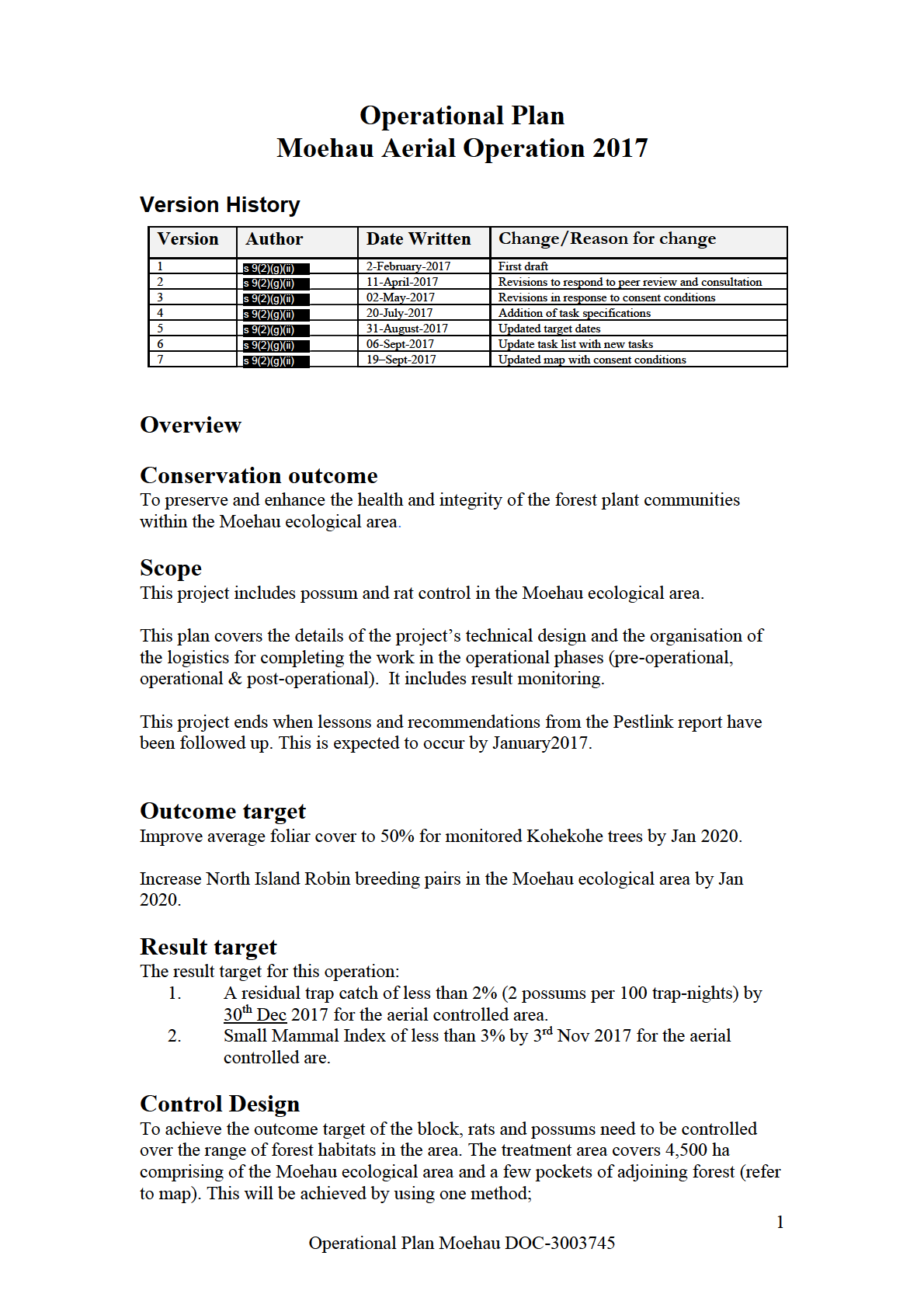
Act
Information
Official
the
under
Released
1. An aerial application of 1080 over 4,359 ha of the block.
The operation is planned to take place between the approved timeframe of 4th Sept
2017 and 31st October 2017. This time has been chosen as the best time to conduct the
operation as possums and rats are more vulnerable to poisoning in winter/early spring
where alternative food sources are seasonally low.
Limiting the re-invasion of possums from habitat adjacent or near the boundary
supports the conservation outcomes that this operation is looking to achieve. To aid
with this, consideration has been given to a coordinated effort with Waikato Regional
Council (WRC) There is DOC farm lease block and a private block totalling about
2700ha to the north west of the Moeahu ecological area, this area is mostly pasture
with pockets of forest habitat. WRC will be carrying out ground control over this area
Act
to aid with lowering the rate of re-invasion into the Moehau ecological area.
Future pest control operations in this area will depend on initial control levels
achieved from this operation and on the rate of re-invasion from adjacent areas. It is
expected that the possum population will take at least five years before they begin to
have a measurable effect on the indicator species. Aerial operations are planned to be
carried out every four years over the next 50 year period with 600ha within the
Moehau ecological area being treated for rats, occurring once yearly except the year
of aerial treatment
Information
One application of 1.5 kg (6 gram baits) per hectare of pre-feed cereal bait will be
sown by helicopter for the aerial operation. Following the pre-feed, 1080 will be
applied at a rate of 2.5 kg (12 gram baits) per hectare for the Moehau ecological area.
The timing of the sowing of the 1080 baits will require a weather window of three
Official
fine nights to achieve maximum toxin uptake.
the
Site Description
Moehau mountain is sacred to local iwi, its full name is Te Moengahau-o-
Tamatekapua – the windy sleeping place of Tamatekapua, the Te Arawa chief and
steersman who had a strong association with the mountain.
under
The summit of Moehau is the burial place of the great chief Tamatekapua who arrived
in New Zealand with the first Polynesian navigators. The prow of his canoe is said to
have been laid with him on Moehau.
With other iwi having strong connection and association with Moehau.
There are numerous Pa sites and middens on the coastal headlands and beaches
surrounding Moehau, during the musket wars local tribes fought on these beaches and
headlands, many of these sites are now Wahi Tapu.
Released
An amazing variety of unique and rare plants and animals live here sharing a diverse
range of habitats from coastal cliffs to sub-alpine grasslands. Moehau contains coastal
pōhutukawa, kauri, tawa (
Beilschmiedia tawa) and podocarp forests, within lowland
and montane bioclimatic zones. Within Moehau forest can be found internationally
significant ecological values including locally endemic Weta and stag beetles, Archey
and Hochstetters frog, Coromandel striped gecko, Pateke (Brown Teal), Kaka,
Bellbird, Grey Warbler, Kakariki (parakeets), Brown Kiwi, Long tailed and Shining
cuckoo, North Island Robin, Kereru and Morepork.
2
Operational Plan Moehau DOC-3003745
Moehau is the northern limit for many southern montane species such as mountain
toatoa and mountain cedar (pahautea). Moehau requires ongoing protection for
nationally threatened and regionally rare plant species. Flora values include
Peraxilla
tetrapetala (Red mistletoe),
Prasophyllum hectorii (swamp leek orchid),
Caladenia
bartlettii, Pittosporum virgatum, Celmisia.incana, Veronica punicea
(Hebe
) and Brachyglottis kirkii var. kirkii (Kirk's daisy).
Land form values include the nationally unique Paritu pluton, a geographical feature
of volcanic origin. Wind and rain sculpture the rugged peak of Moehau that rises
steeply from the sea. At 892m it is the highest point on the Coromandel Peninsula.
Values
Act
Moehau is a notable area which has been identified under the Natural Heritage
Management System (NHMS) as a high priority site. This area is prioritised for
management because of the high conservation values. In some instances, this relates
to threatened biodiversity such the nationally vulnerable Coromandel Brown Kiwi
Apteryx mantelli. In other cases, there are unique ecosystems present, such as the sub-
alpine grasslands at the top.
Threatened species
Information
Coromandel brown kiwi
Coromandel Brown Kiwi (CBK) are present in the operational area. CBK’s are the
rarest of the North Island brown kiwi taxa with an estimated 900 pairs across the
Coromandel. Kiwi densities are highest in the northern regions of the Peninsula,
making Moehau an important area for CBK.
Official
North Island Robin
About 100 North Island Robin from Pureora Forest park were released into the
the
Moehau area, 61 of those birds were released on public conservation land on the
eastern side of Mt Moehau at Stony Bay in 2009 and 2011. 30 birds were released in
2009 on 300 ha of privately owned land just south of Stony Bay. Moehau is the only
place in the Coromandel region to have North Island Robin.
under
Long-tailed bats
Long-tailed batshave been found in the Moehau ecological area and are likely the
only native land mammal on the Coromandel. Searches continue for short-tailed bats,
but none have been found to date.
Threatened plants
Brachyglottis kirkii var. kirkii (Kirk's daisy) At Risk – Declining
Released
Peraxilla tetrapetala (Red mistletoe) At Risk - Declining
Prasophyllum hectorii (swamp leek orchid) At Risk - Declining
Caladenia bartlettii At Risk - Naturally Uncommon
Pittosporum virgatum At Risk - Naturally Uncommon
Veronica punicea (Hebe)
At Risk - Naturally Uncommon
3
Operational Plan Moehau DOC-3003745
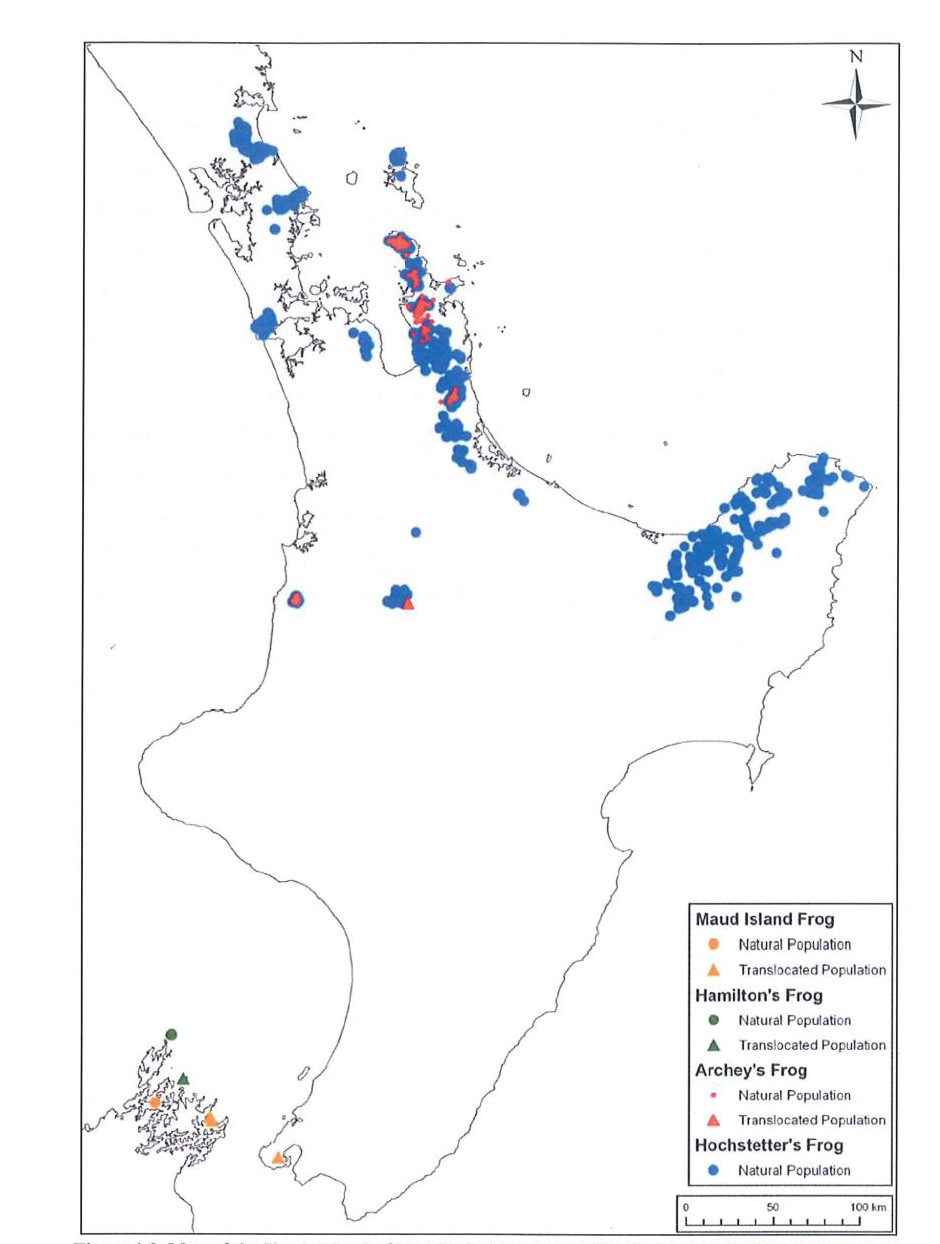
Archey’s frog
The Coromandel Peninsula is home to much of the threatened Archey’s frog range.
The only other places they are found include a small coastal forest block in the King
Country, Maungatautari and captive facilities such as the Auckland Zoo. The
Coromandel represents the national stronghold for Archey’s frog (see below).
Act
Information
Official
the
under
It has been proven that rat predation has a significant impact on Archey’s frog
populations and that rat control has a positive impact (see Whareorino research).
Juvenile froglets on the back of an adult male were observed within the Papakai pest
control operational area during a monitoring session in early 2014. This was direct
evidence of breeding success.
Released
Iconic species
In addition to high priority threatened species, there are also iconic species throughout
the block, the Moehau stag beetle, is one of the more unusual species that inhabit the
mountain
. Kauri
The Moehau ecological area includes impressive stands of Kauri. Kauri are a
significant species, influencing community species composition through alterations to
soil chemistry. Kauri are under threat from kauri dieback disease (Phytophthora
4
Operational Plan Moehau DOC-3003745
Taxon Agathis), which has recently been confirmed on the Coromandel for the first
time.
Freshwater fish
Native freshwater fish have been recorded throughout the several catchments in the
operational area including: short jawed kokopu, banded kokopu, inanga, long finned
and short finned eels, koura, torrent fish and red finned bullies inhabit the streams.
Threats
Animal pest species present in the reserve are: stoat, weasel, Norway rat, ship rat,
mouse, hedgehog, cat, pig, rabbit and possum. The most recent trap catch results (July
2016) for the Moehau ecological area is 6.3 possums per 100 trap nights.
Introduced pests are having major impacts on Moehau flora and fauna. Possums are
Act
causing mortality of canopy trees like rata and kohekohe through defoliation. Possums
have been managed since 1989 with trapping starting in Port Jackson and then
moving southward. The first toxin used between 1995 and 2000 was brodifacoum in
bait stations set out on a grid approximately 150m apart. DOC discontinued the use of
brodifacoum in 2000 and possums have been controlled around parts of Moehau using
other toxins approximately every 4 years, with a first aerial application of 1080 in
2012 over 4500ha achieving a result of 0% RTC.
Information
Ship rats are abundant and together with mice, are opportunists, eating both
vegetation and animal matter. Rats predate heavily on Weta, beetles, spiders, moths,
stick insects, cicadas, native snails and frogs, slugs, and lizards. Seasonal food
includes bird eggs and chicks. Rat numbers increased on Moehau once Mustelid
trapping was initiated in 1995, rat control begun with trapping using victor traps in
Official
northern stony bay in 2002 and 2003 (Murphy 2004) followed by Diphacinone in bait
stations laid on a grid approximately 75m apart in 2004. Since then low rat numbers
have been maintained at Stony Bay using a 75m grid system over 1500 ha (reduced to
the
600ha in 2015) using toxins including 1080.
Mustelids (weasels, ferrets and stoats) and feral cats are present. All four species
threaten conservation values by preying on vertebrate and invertebrate populations,
but the most destructive is the stoat. Stoats are adept tree climbers and, along with
under
ship rats, will predate birds, nestlings, eggs, lizards and invertebrates within the
canopy.
Mustelid especially stoats are affecting kiwi through chick predation., in 2000 a
trapping grid was set up on Moehau covering approximately 1800hec, 1600 traps are
laid 200m apart on selected ridges, roads etc. Since trapping was introduced to
Moehau kiwi chick survival has averaged 77% of all chicks produced by tagged
Kiwis over the years 2000 to 2005.(De Monchy2005).
Released
Hedgehogs are also present, mainly preying on native invertebrates. The extent to
which hedgehogs, rodents and pigs affect snails at this site is unknown.
Goats were first controlled by government hunters on Moehau in 1956 but sustained
control at regular intervals did not occur until 1981 with their final removal occurring
in 2005, since then only a couple of goats have been shot and their presence or how
they got there was unknown, but most likely from neighbouring farms.
5
Operational Plan Moehau DOC-3003745
Cattle from neighbouring farms have historically grazed the accessible parts of
Moehau have caused considerable damage to the understorey. In the last 10 years,
boundary fences have been erected around most of the mountain except in the south
west corner made up of the Tehope, Ongohi and Urarima catchments. Grazing is still
occurring in parts of these areas and a completed boundary fence around Moehau will
be a longer-term goal.
Cats are controlled around Moehau to protect Pateke from predation, 43 traps have
been maintained since April 2011.
Pigs are present on Moehau and cause damage to the forest ecosystem. A seasonal
ballot has been the control method for pigs in recent years.
Act
Considerable forest modification has occurred in the last 100 years, goats, possums
and cattle have depleted many species on the forest floor and in the canopy.
Accessible areas of the mountain were logged or cleared for farmland also in this
period, parts of the land cleared for farming is now regenerating.
Issues
Treatment area is under Treaty claim, which could raise some sensitive issues
Information
between local Iwi and the Department. Due to sufficient consultation and engagement
this should be limited.
Deeply dissected valleys, rugged terrain, steep slopes, and bluffs means access on foot
will be difficult and unsafe in places
Some of the boundaries in the area around the operational area do have unfenced or
Official
sensitive areas, this concern could be mitigated through consultation or movement of
the operational boundary and or stock.
Neighbouring landowners rely on rainwater for domestic supply, and streams for
the
stock water.
Conflict with local pig hunting groups and the lack of access after the operation will
be considered during the consultation process, but the choice of timing for the
operation should be more in favour of the pig hunting groups due to the block not
being closed during the winter. Bait and carcass monitoring will be put in place in
under
place to possibly shorten the stand down period of the area after the operation is
conducted.
Other management at the site
Released
Past:
Control Method Pestlink
Year
Operation Name
Ref
Ship rat Control in Te Mauri o
Baitstation
2015-2016
1516HAU03
Moehau
Possum, Ship rat Control in Te Mauri Aerial 1080
2012-2013
1314HAU01
o Moehau 2013
Possum, Ship rat Control in Moehau Hand lay –
2006-2007
0607HAU02
West - Cape Colville
Feratox, Feracol
6
Operational Plan Moehau DOC-3003745
Possum, Ship rat Control in North
Baitstation –
2005-2006
0506HAU01
East Moehau rat block
1080, Racumin
Possum Control in Te Mauri o
Baitstation - 1080
2004-2005
0405HAU09
Moehau - Urarima (2004/05)
2003-2004 Goat Control in Moehau (2003/04)
Hunt - Ground
0405HAU12
Ship rat Control in Northeast Moehau Hand lay -
2003-2004
0405HAU07
rat block
Racumin
Baitstation –
Ship rat Control in Northeast Moehau Diphacinone
2003-2004
0405HAU06
rat block (2003/04)
Hand lay -
Racumin
2002-2003 Goat Control in Moehau (2002/03)
Hunt - Ground
0405HAU10
Act
Ship rat Control in Northeast Moehau Trap - Kill
2002-2003
0405HAU05
rat block (2002/03)
Possum Control in Te Mauri o
Baitstation -
2002-2003
0304HAU03
Moehau (2002/03)
Feratox
Ship rat Control in Te Mauri o
Trap - Kill
2002-2003 Moehau - Poley Shag Bay/Stock
0203HAU22
Track
Possum Control in Te Mauri o
Baitstation -
Information
2001-2002
0809HAU02
Moehau 2001/02
Feratox
Hand lay –
Possum Control in Te Mauri o
2000-2001
Cyanide
0405HAU08
Moehau - Urarima (2000/01)
Trap - leghold
2000-2001 Goat Control in Moehau 2000/01
Hunt - Ground
0203HAU31
Official
Possum Control in Te Mauri o
Baitstation -
2000-2001
0203HAU13
Moehau - Western Block
Talon
the
Possum Control in Te Mauri o
Baitstation -
2000-2001
0203HAU12
Moehau - Fletchers Bay Block
Feratox
Possum, Ship rat Control in Te Mauri Baitstation -
2000-2001
0203HAU01
o Moehau - Mt Homebush
Cholecalciferol
under
Possum Control in Te Mauri o
Baitstation -
1999-2000
0203HAU02
Moehau-Eastern Block
Talon
1998-1999 Goat Control in Moehau 1998/99
Hunt - Ground
0203HAU32
Possum Control in Te Mauri o
Baitstation -
1998-1999 Moehau - Mt Homebush-Fletcher
Talon
0203HAU14
Bay/Ongohi
Possum Control in Te Mauri o
Baitstation -
Released
1997-1998
0304HAU12
Moehau (1997/98)
Talon
1997-1998 Goat Control in Moehau 1997/98
Hunt - Ground
0203HAU41
1996-1997 Goat Control in Moehau 1996/97
Hunt - Ground
0203HAU42
1995-1996 Goat Control in Moehau 1987 - 1996 Hunt - Ground
0203HAU43
1986-1987 Goat Control in Moehau 1979 - 1986 Hunt - Ground
0203HAU44
There is no other management planned for this site at this stage.
7
Operational Plan Moehau DOC-3003745

Act
Information
Official
the
under
Released
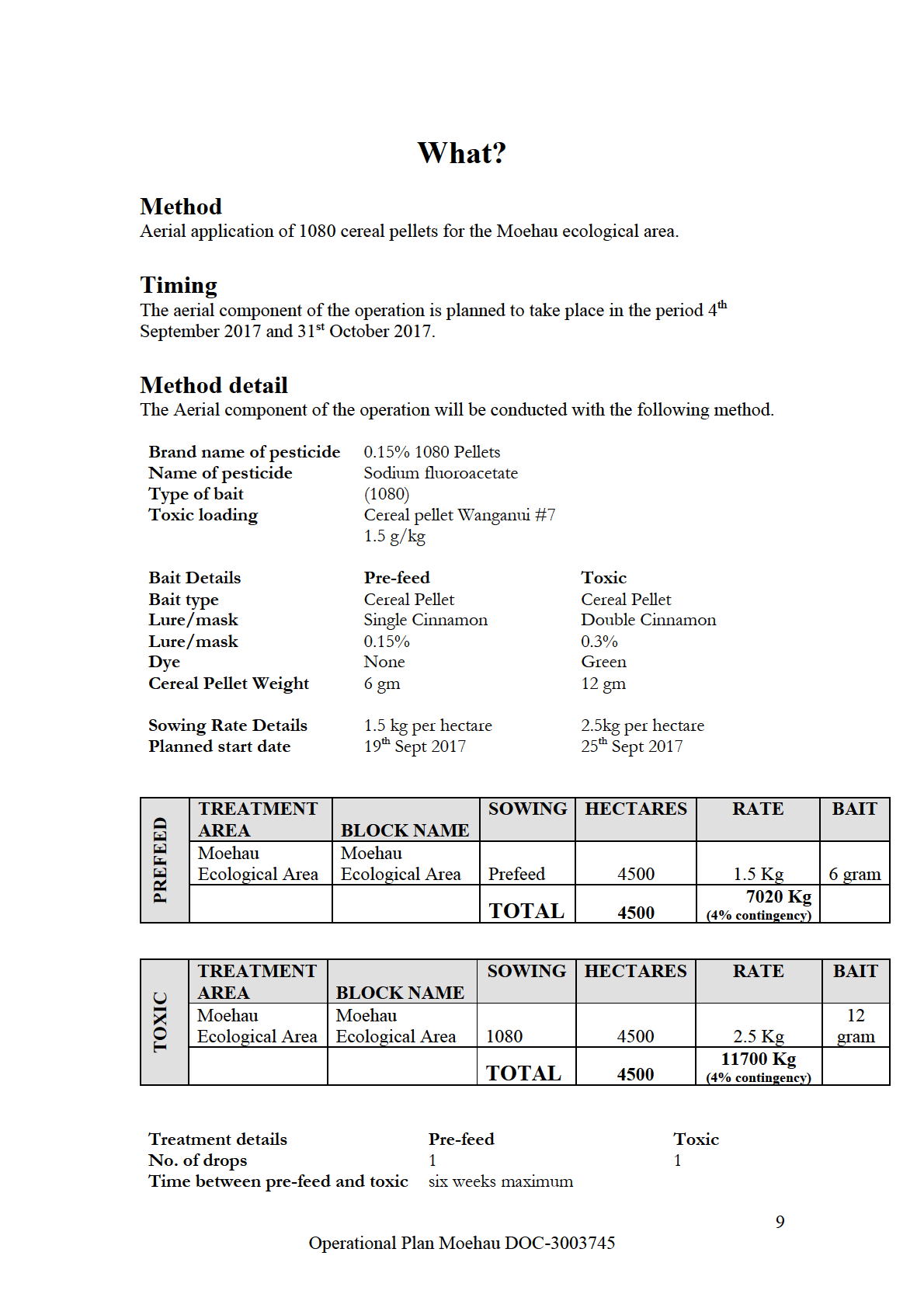
Act
Information
Official
the
under
Released
Aircraft type
Helicopter
Number of Aircraft
2-3
Loading Method
Truck mounted crane and
hopper
Bait Type
This project will use 0.15% 1080 Pellets using Wanganui #7 20mm (12 g) baits. Baits
will be ‘double’ cinnamon lured (0.3%).
Bait Transport
Bait will be transported to the site by the helicopter contractor.
Pre-feeding
Act
Pre-feeding using non-toxic Wanganui #7 cinnamon lured 16mm (6g) bait will begin
in the first suitable weather window on or after 03 July 2017. Pre-feed baits will be
sown at a rate of 1.5kg/ha a forecast of at least 2 nights with less than 10mm of rain in
any 24 hour period will be required
Toxic Baiting
Toxic baiting will follow at the first available weather opportunity at least 5 days after
pre-feeding but not exceeding 6 weeks. In case no weather window eventuates within
this allowable interval there will be another prefeed application applied. Toxic bait
Information
will be sown at 2.5kg/ha,a forecast of at least 3 nights with less than 10mm of rain in
any 24 hour period will be required.
Bait loading
Despite using non-toxic baits the loading of pre-feed will be treated as a ‘dress
Official
rehearsal’ for toxic baiting so loading crews will wear full PPE as per Safe Handling
Sheet 1. The contractor will supply all loading, driver, and delivery personal. The
the
loading system will be debriefed at the end of pre-feeding and improvements made
for the toxic baiting.
Clean up and disposal
Empty bags will be bundled into wool fadges on site and returned to the Coromandel
under
DOC workshop bait store for later disposal. The helicopter transport truck decks will
be inspected and swept before back-loading empty pallets and bags to the Coromandel
DOC workshop bait store at the completion of toxic baiting. The helicopter bucket
and loader will be washed down with high pressure water after first removing any
visible pellets remaining. The loading site itself will be fenced off. Fencing and
loading site signs will remain in place until 50mm of rain has fallen on the site.
Contaminated PPE will be disposed with empty toxic bait bags.
Released
Outcome and Result Monitoring
Result monitoring
When monitoring the effectiveness of the operation, it is considered essential to
measure:
• the abundance of possums in a treatment area prior to control (influences choice
of control technique)
10
Operational Plan Moehau DOC-3003745
• Whether the operation has reduced possum abundance to the target residual catch
rate.
• Whether the operation has reduced rat abundance to the target small mammal
index (SMI).
For possums, the residual trap catch rate is an expression of how many animals are
caught per 100 trap nights. For forest recovery to occur the target residual catch rate
is 5%. The Department of Conservation uses a standard trap catch monitoring
protocol (NPCA 2005).
For this operation, 20 lines of 10 raised-set leg hold traps, that will be in accordance
with the most up to date NPCA guidelines for possum monitoring methodology
published in 2015, available at www.npca.org.nz.. The pre-operational monitor lines
Act
will be run in June 2016 and the post-operation monitor lines will be run in the period
2 to 3 months after the toxic bait application.
SMI monitoring will occur across 1000ha on the eastern side (around Stony Bay area,
including the 600ha rat block); these results will also be used to indicate the reduction
in rat abundance over the rest of the control area. The pre-operational monitor lines
will be run in June 2017 and the post-operation monitor lines will be run in the period
2 to 6 weeks after the toxic bait application with reoccurring monitoring after the first
Information
post operation monitor every 2 to 6 weeks to gauge rat population recovery timelines.
Outcome monitoring
Vegetation monitoring to assess the achievement of outcome targets will be
conducted every five years and results analysed to identify changes in forest health.
Vegetation monitoring focuses on a few plant species (indicator species) known to be
Official
vulnerable to possum damage. Part of the operation’s success will be assessed using
vegetation monitoring results. This information will assist decisions on the timing of
the
future possum control. Methods to be used are:
• Foliar browse index: assessment.
under
Released
11
Operational Plan Moehau DOC-3003745
How?
Consents required:
1. Landowner or occupier consent
Yes
No
2. Resource consent
Yes
No
3. Public health permission
Permission
Notification
Not required
Act
4. DOC permission
Yes (operation involves pesticides)
No (traps or hunting only)
5. EPA permission
Yes
No
Information
Official
the
under
Released
12
Operational Plan Moehau DOC-3003745

Act
Information
Official
the
under
Released
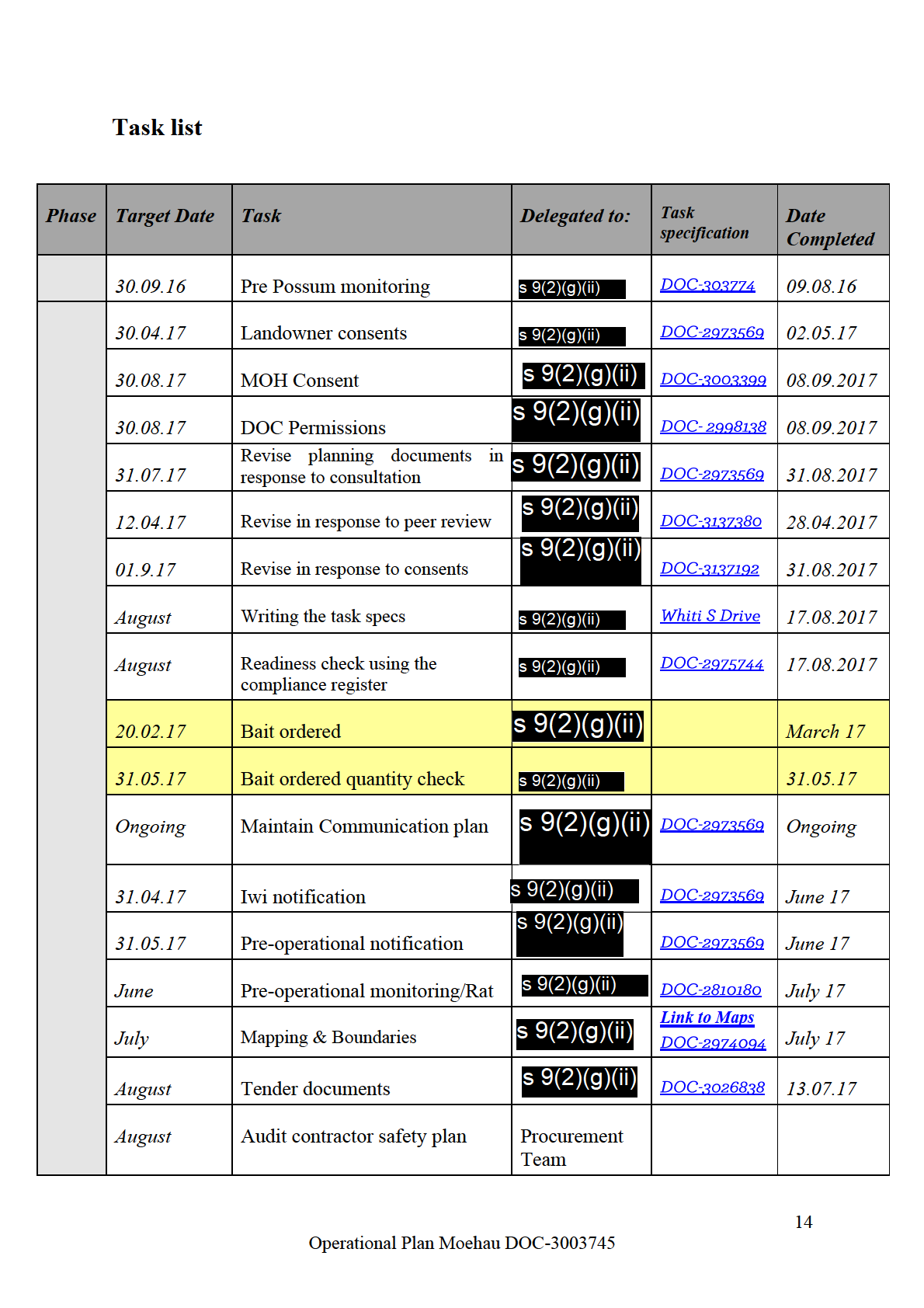
Act
Information
Official
the
under
Released

Act
Information
Official
the
under
Released
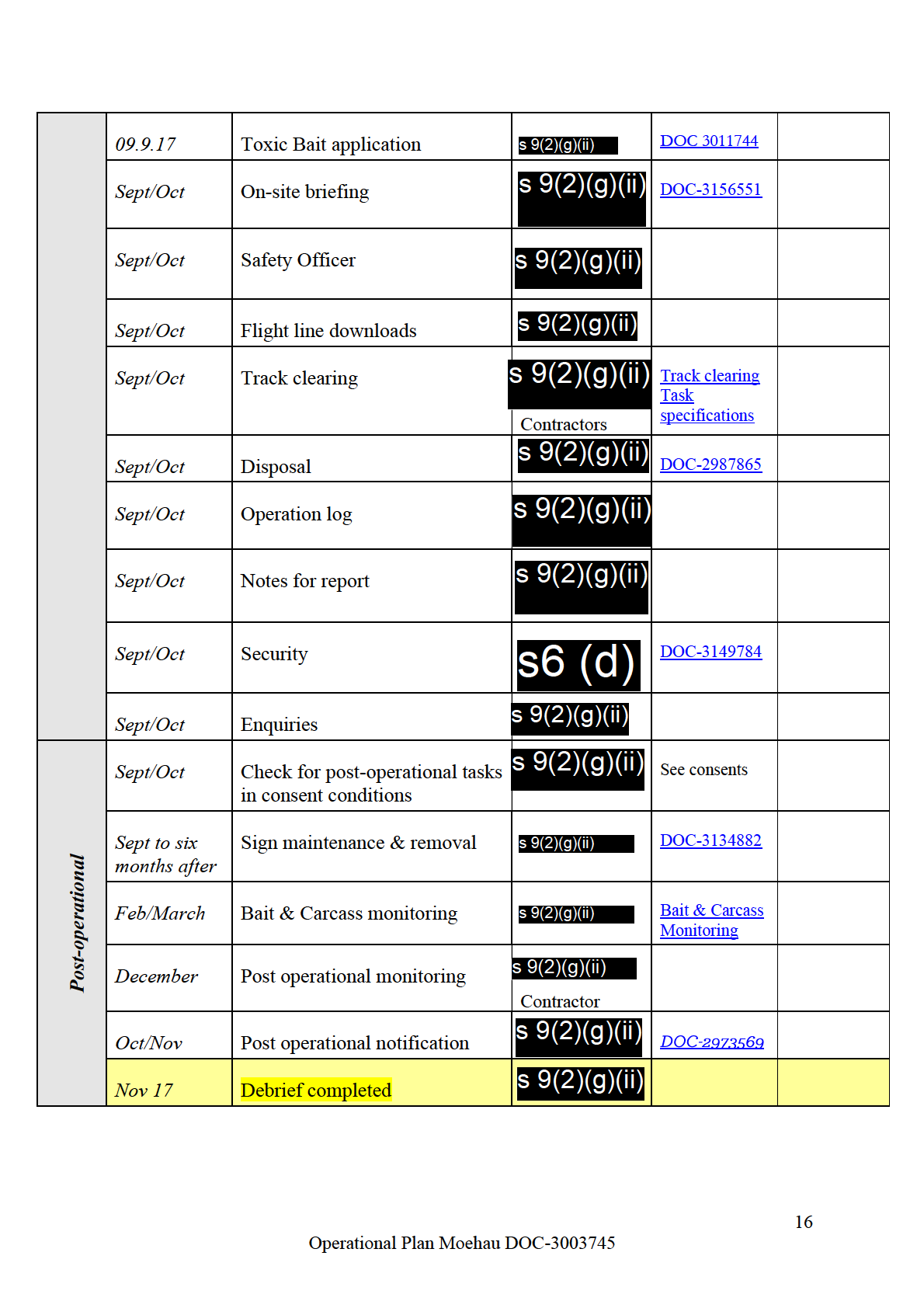
Act
Information
Official
the
under
Released
Deliverables Document Index DOC-2973566
Communication Plan – Moehau Pest Operation 2017 DOC-2973569
DOC Application Moehau DOC-2998138
Contract for aerial application of 1080 baits DOC-3152015
MOH Moehau DOC- 3003399
Emergency Response Plan – Pre-Feed DOC-2988085
Emergency Response Plan – Toxin DOC-2987865
Warning sign register DOC-3134882
Safety briefing DOC-3156551
Act
Information
Official
the
under
Released
17
Operational Plan Moehau DOC-3003745







